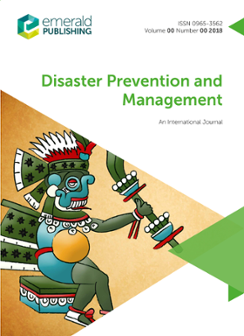Disaster Prevention and Management: Volume 23 Issue 4
Strapline:
An International JournalTable of contents
Social capital in disaster risk management; a case study of social capital mobilization following the 1934 Kathmandu Valley earthquake in Nepal
Roshan Bhakta BhandariThe purpose of this paper is to examine how social capital operated in the lives of 15 respondents from Lalitpur following the massive 1934 Kathmandu Valley earthquake. Based on…
Optimal allocation of emergency response services for managing disasters
Evangelos Mitsakis, Iraklis Stamos, Jose Maria Salanova Grau, Georgia AifadopoulouThe purpose of this paper is to present and apply a methodology that optimally assigns emergency response services (ERS) stations in Peloponnesus, Greece that was severely hit by…
Can education reduce Middle Eastern fatalistic attitude regarding earthquake disasters?
Hoda Baytiyeh, Mohamad K. NajaThe purpose of this paper is to discuss the unique and necessary role that Middle Eastern educational institutions must play to reduce the negative influence of fatalism regarding…
Stakeholders’ approaches to disaster risk reduction in built environment
S. Mohammad H. Mojtahedi, Bee Lan OoIn disaster risk reduction (DRR), it is important to realise stakeholders’ approaches against disasters in the built environment. The purpose of this paper is to explore why…
Implementing disaster preparedness education in New Zealand primary schools
Victoria A. Johnson, Kevin R. Ronan, David M. Johnston, Robin PeaceThe purpose of this paper is to assess the national implementation of disaster preparedness education in New Zealand primary schools through the dissemination of What's the Plan…
Integrating social science research into wildland fire management
Michael Czaja, Stuart P. CottrellSocial science research is used to support the formulation of natural resource management decisions with accurate and timely information. Due to risk and potential impacts, this…
Vulnerability to flood-induced public health risks in Sudan
Haitham Bashier Abbas, Jayant K. RoutrayThe purpose of this paper is to analyze flood vulnerability vis-à-vis flood-induced health risks, and understand the relationship between them to suggest measures to reduce health…
Issues raised by nurses and midwives in a post-disaster Bantul community
Mire Sugino, Elsi Dwi Hapsari, Ema Madyaningrum, Fitri Haryant, Sri Warsini, Satoshi Takada, Hiroya MatsuoBantul in Central Java was the most severely damaged area by a devastating earthquake in May 2006. Even after being victims themselves, nurses and midwives at public health…
Menstrual management: a neglected aspect of hygiene interventions
Alison H. Parker, Jen A. Smith, Tania Verdemato, Jeanette Cooke, James Webster, Richard C. CarterEffective menstrual management is essential for the mental and physical well being of women. However, many women in low-income countries lack access to the materials and…
Determinants of HADR mission success: exploring the experience of the Malaysian army
Aida Idris, Saiful Nizam Che SohThe purpose of this paper is to empirically explore issues in humanitarian aid and disaster relief (HADR) missions and examine the effects of selected factors on mission success…
The Brisbane flood: CALD gatekeepers’ risk communication role
Jeanette Shepherd, Kitty van VuurenThe purpose of this paper is to present the results of an original research project that explored the experiences and actions of immigrant and refugee communities during the 2011…
What makes disaster donors different from non-donors
Tatsuya NogamiThe purpose of this paper is to explore what would make disaster donors different from non-donors, with particular attention paid to differences in two forms of donations: the…

ISSN:
0965-3562Online date, start – end:
1992Copyright Holder:
Emerald Publishing LimitedOpen Access:
hybridEditors:
- Dr JC Gaillard
- Dr Emmanuel Raju